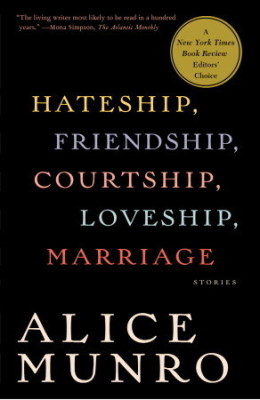By turns both lovely and frustrating, Alice Munro’s book of nine new stories, Hateship, Friendship, Courtship, Loveship, Marriage, offers a realistic window into life’s misfortunes and truths, its delicate moments and unexpected pleasures. Just as the final story in the collection follows its main character through the slow process of losing her memory and mind, shadowing a husband willing to do anything to preserve her sanity and life, so does Munro’s collection try to preserve the essence of life—its imperfections, contradictions, and repetitions—at all costs. These stories openly consider death, adultery, old age, mental illness, and broken trust. Her writing mirrors the most essential aspects of life—inconsistency and irony, endless reiteration mixed with constant change.
Early in the title story, Munro describes a suit that Johanna, the protagonist, tries on: “It feels as light as silk, but it wears like iron.” This amounts to a description of the story itself. The language is light—“when she was finished it shone like candy. Maple candy—it was bird’s-eye maple wood. It looked glamorous to her, like satin bedspreads and blond hair.” But the content is weighty: Johanna, a housekeeper for a girl named Sabitha and her father, falls in love with the first husband of Sabitha’s mother. The affair begins in a series of love letters that have actually been faked by Sabitha and her best friend. Johanna believes the letters to be genuine and arranges to leave the city and Sabitha in order to live with her imagined-beau out West. However, Munro turns the children’s joke on Johanna into a marriage for the old housekeeper, whose life is soon filled with “such a warm commotion, such busy love,” forcing us to consider why we had expected a particular ending anyway, to wonder about this element of the unexpected, to search our own lives for similar pearls.
The title story is nearly the only one that avoids revolving around a death or an unfaithful partner. The ubiquitous one-time affairs and continual presence of death tended, after many reiterations, to lose their novelty, and by the end of the collection I was tired and jaded. Of course, life is itself this kind of variation on themes, and Munro both relishes this and illuminates it for those of us who might not even have bothered to look for the delicate differences within the repetitions, to wonder about their importance or to revel in their realities.
On the other hand, Munro’s stories often feel disjointed, and it is likely that she could have successfully created a realistic collection of stories with about half the “drama,” which at times feels forced and irregular. “Post and Beam,” the sixth story in the collection, opens with the sentence, “Lionel told them how his mother had died,” and a short paragraph describing how his mother had slowly applied her makeup and then requested that her husband (a minister, incidentally), be called, because “she was only about five minutes out, in her prediction.” This puzzling opening leads into a story not about Lionel and his mother, or about her illness, or about how he coped with her death, as one might imagine, but about two of Lionel’s friends, Lorna (to whom Lionel writes mysterious nonsense poems) and her husband, Brendan. Polly, a “country cousin” of Lorna, comes to visit them in their middle class house. And that, with some nuances of longing, a tad of unexpected friendship, a lesson on bargaining with God, and a few additional details, completes the story. No further mention of Lionel’s mother or her death; these facts seem to serve primarily to open the story in an interesting way—which they accomplish, but at the expense of unnecessary drama, undermining the real drama in some of Munro’s other stories.
The strongest story in the collection, “Comfort,” is like a gem among finely polished stones. The introductory paragraph is long enough to introduce the two main characters in the story—Nina and Lewis—and to make us feel comfortable, but without an excess of detail or background. The story continues to tell of how the two learned to cope with Lewis’ fatal illness and the difficult question of suicide in the face of extreme pain or discomfort, an action that both had agreed was justified. A combination of remembrance of life and struggle to accept grief, Munro’s story follows Nina closely through the days succeeding the death of her husband, beautifully weaving together Nina’s initial denial of pain followed by her final acceptance of it as a new part of her life. Although this story does not incorporate the complexity of numerous characters or an elaborate plot, it is these aspects of the story which make it so successful. By the end of the story I felt complete, as if I had traveled through a rough terrain and finally gotten the chance to rest. The last paragraph in “Comfort” is especially lovely, stunning in its beauty and realism, indeed a comforting end to a difficult tale.
This is the way in which Hateship, Friendship, Courtship, Loveship, Marriage portrays life in all its rawness. It is the very frustration sewn into these stories—their constant shifts of time and perspective, their quick acquaintance with many characters, and their successions of deaths and failures of faith—that creates a collection of such competence. It is this repetition and the keen variations within such repetition that makes us stop and reconsider our lives. Munro transforms the frustration experienced by us, her readers, from a significant weakness into a realistic strength. Munro does not deprive us any of life’s ugly realities, but she also does not deprive us life’s beauty, whether it be in friends or family, comfort or closure, an elegantly written sentence or a precisely composed short story.

